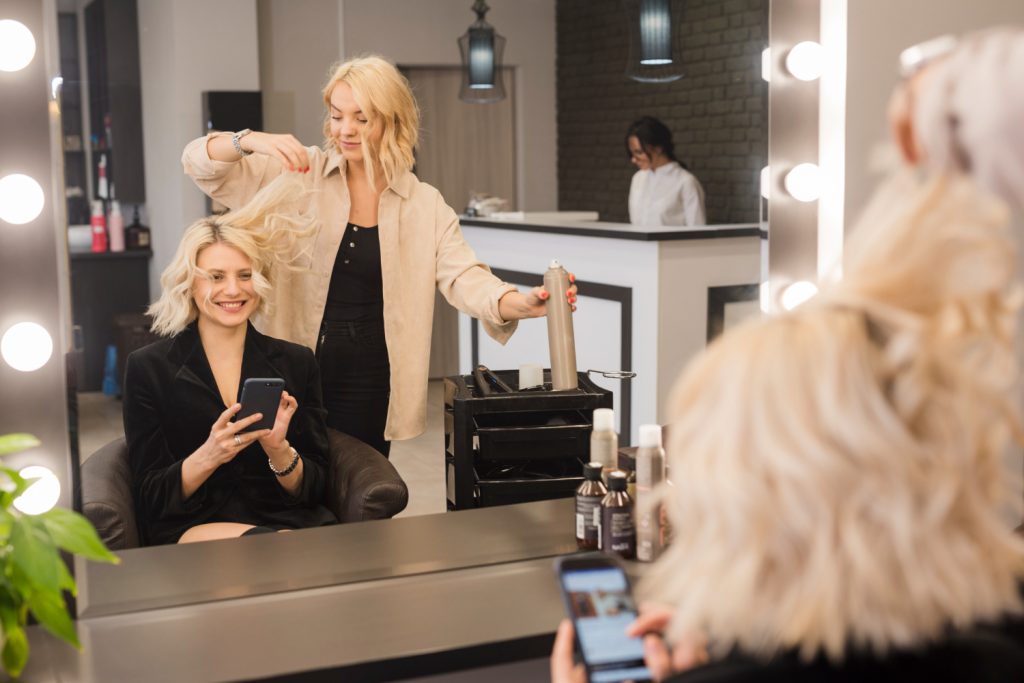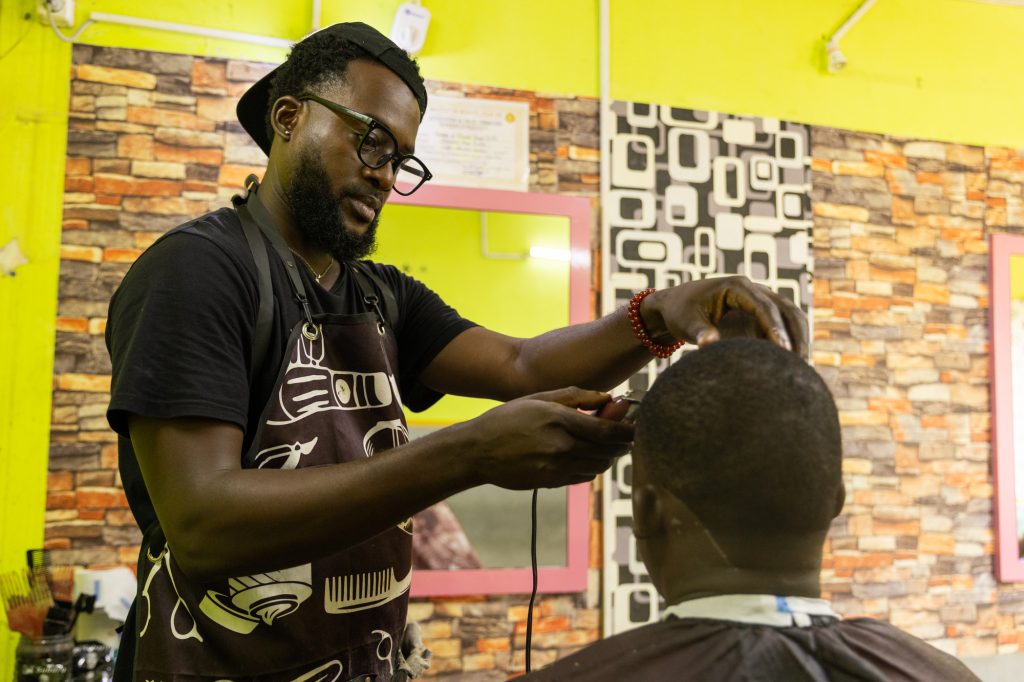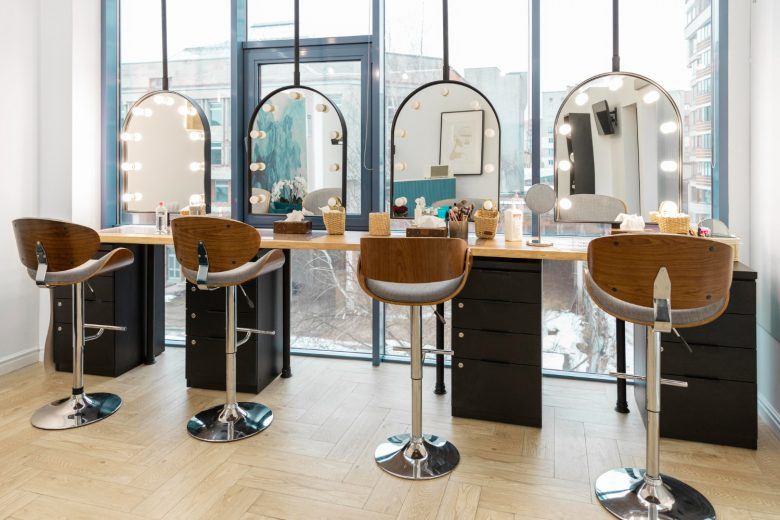For many people, a trip to a beauty salon is something to look forward to. Many people love the idea of going someplace to improve their looks, feel better about themselves, and socialize with others. Centuries ago, beauty stylists and barbers helped the rich and powerful with their grooming habits. Emperor Nero, the tyrant of Greece had barbers at his employ and a man named Champagne opened a hair salon in Paris and styled wealthy Parisian women until his death in 1658.
Today, most people still go to some kind of beauty salon to improve their appearance. This presents a great opportunity for entrepreneurs who are interested in entering the beauty business as a barber, stylists, or makeup artists. In this article, we will take a deeper look at the beauty salon business model, the different types that exist, and some of the pros and cons of this model.
The Beauty Salon Model
The beauty salon industry operates on a dynamic and customer-focused business model, which is key to its success and sustainability. At its core, this model revolves around providing a wide range of personal care services such as hair styling, coloring, cuts, skincare, nail care, and makeup application. Many people think of hair salons or barbershops when the term “beauty salon” is used. However, there are many types of businesses that fall under this model. We will look at those later in the article.
This model falls under the retail business model. You can also assume that this would be a brick-and-mortar business as you need to be physically present to take advantage of the services offered, Salons often diversify their services to include treatments like massages and aromatherapy, catering to a broader clientele seeking holistic wellness experiences.
Central to the beauty salon business model is the emphasis on customer experience. Salons invest significantly in creating a welcoming and comfortable atmosphere, where clients can relax and enjoy their treatments. This is achieved through stylish interior design, comfortable seating, and a selection of complimentary amenities like beverages and magazines.
Also, skilled and trained professionals are the backbone of the industry. Their expertise not only in beauty treatments but also in understanding client needs and preferences is vital. Continuous training and staying abreast of the latest trends and techniques is a priority for these professionals.
Now let’s take a look at the different types of beauty salons that fall under this business model.

Image by Freepik
Types of Beauty Salons
Before we get into the details of this model, let’s clarify the types of businesses that fall under this model. Here are some of the different types of salons that are in existence.
- Hair Salon: When people think of beauty salons they tend to focus on hair salons. These are places where customers go to get their hair cut, colored, and styled.
- Nail Salon: This type of salon focuses primarily on nail care services. You’ll see them offer things like manicures, pedicures, nail extensions, and nail art. Some nail salons also offer additional services like foot massages and exfoliation.
- Day Spa: The day spa gives clients the option to enjoy facials, massages, body treatments, and sometimes hair and nail services. These salons focus on relaxation and rejuvenation.
- Barbershop: Barbershops are hair salons whose target audiences are mostly men and boys. The first known barbershops were in ancient Greece, where barbers were an esteemed group. Today, the barbershop is an important part of men’s grooming and also, often, male socializing.
- Tanning Salon: These types of salons specialize in services to tan the skin. They provide sunbeds and sometimes spray tanning. These salons may also offer complementary services like body exfoliation to prepare the skin for tanning.
- Makeup Studio: These studios are dedicated to makeup services for events, weddings, or everyday looks. Beyond that, these studios can sometimes offer makeup lessons and some sell makeup products.
Revenue Options for This Model
Direct Service Charges
The most common revenue option for beauty salons is the direct charge option. This means that clients pay directly for the services charged. Hair salons, day spas, barbershops, and nail salons are the most common types of salons that use this option.
The pricing for these services is usually based on the type of service. For example, a basic haircut may cost $25 at a chair barbershop. However, a hair salon studio may charge $70 for an expert cut. The price is also influenced by the materials and products used. Salons may offer a range of services from basic grooming to luxury treatments, each priced accordingly.
Product Sales
Many salons have the opportunity to upsell by offering products for sale. When a client purchases a service such as hair styling and facial treatment, they can purchase the products used during the service that they can take with them. This is an attractive option for the client. If the client likes the way they look and feel after their service at the salon, they can maintain that look and feel by purchasing the products used during their treatment. Product sales should be a primary goal of beauty salons.
These products can include shampoos, conditioners, styling products, skincare items, and cosmetics. This is an opportunity the salons do not want to miss out on. That is because this revenue stream can be very lucrative. According to Salon Today, products in the salon are sold at a profit margin of 42 to 48% profit margin compared to 36-40% for services.
Also, with in-store products, the opportunity to convert sales is higher than in retail stores that are not within the salon itself. That is because customers often trust the recommendations of their stylists or beauticians. On top of that, they can see the results of the products right away after the service.
Memberships
Offering memberships is a strategy to generate consistent revenue and build a loyal customer base. You’ll see tanning salons and day spas utilize this revenue option more than other salons. Although, it is important to note that every type of salon can utilize this option.
Salons can take advantage of the membership option by offering special benefits for members. These benefits can include discounted services, priority booking, and exclusive access to new services or products. Makeup studios can also offer things like special members-only events. Memberships encourage repeat visits and can increase customer loyalty. These members often feel as though they are getting more value for their money.
The membership option is based on the subscription business model. One advantage of the subscription business model is that it provides the business with a predictable, steady income stream. This can be really beneficial for budgeting and financial planning. Salons can offer different levels of memberships with varying benefits to cater to different customer needs and preferences.
Advantages of This Business Model
Creative Expression and Personal Satisfaction
Owning a beauty salon offers a unique platform for creative expression. As an owner, you have the freedom to design the salon space, choose the services offered, and cultivate a distinctive atmosphere.
This creative control can be deeply satisfying, especially when you see your vision come to life and receive positive feedback from clients. Additionally, the beauty industry is dynamic and constantly evolving, which allows for continuous learning and adaptation of new trends and techniques, keeping the work exciting and fulfilling.
Growing Market and Demand
According to multiple reports, the global beauty salon market size was valued at $155.60 billion in 2022 and is expected to grow at a compound annual growth rate of 8.0% from 2023 to 2030.
People consistently seek beauty services for various occasions. People often like to have a regular salon that they can visit once every few weeks to get their hair done or another type of beauty treatment. They also like to have a place they can go to prepare for special events. This steady demand can translate into a reliable customer base and potential for revenue growth.
As beauty trends evolve, there’s always an opportunity to expand services and cater to diverse client needs, further boosting business potential.
Relationship Building and Community Impact
A beauty salon is not just about providing services; it’s a place where relationships are built. Owners often develop strong bonds with their clients, understanding their preferences and personal stories. They also have the opportunity to create a community feel around their shop. This importance has been seen in media over the years,
Rapper Ice Cube produced and starred in a movie franchise called Barbershop. The movie showcased how the barbershop feeds into the aspect of community.
NBA superstar LeBron James also displayed how important barbershop conversations are to a community. In 2020, he starred in a television series called The Shop which premiered on HBO. The series featured James and businessman Maverick Carter having conversations and debates in a barbershop with guests who were mostly professional athletes.

Salons of all kinds offer clients to get to know their stylist, other patrons, and the salon owners during their visits. This can help create a bond between them and enhance customer loyalty.
Disadvantages of the Business Model
High Competition
One of the major downsides to this model is the level of competition that already exists in this arena. According to IBIS World, here are the numbers of locations in the US for each type of beauty salon.
- Day spas-23,00
- Tanning Salons-57,283
- Barbershop- 154,876
- Hair Salons-952,909
- Hair and Nail Salons-1,464,924 Hair & Nail Salons
Needless to say, there are no shortages of beauty salons out there. However, entrepreneurs entering this space should not be intimidated by the amount of competition. They should look to find the target market for the beauty salon within the space and focus on filling the needs not met by their competitors.
Time Commitment and Work Pressure
Running a salon requires a significant time investment, often extending beyond regular business hours. Owners need to manage administrative tasks, staff, inventory, and customer service, which can lead to long and irregular working hours.
The pressure to stay competitive and keep up with industry trends can also be taxing, both mentally and physically.
Staff Management Challenges
Managing a team of professionals with different personalities and work ethics can be challenging. Issues such as staff turnover, training, conflict resolution, and maintaining high service standards require strong leadership and management skills. Ensuring staff satisfaction while keeping up with salon standards and client expectations can be a delicate balance to maintain.
Dependence on Market Trends and Customer Preferences
The beauty industry is heavily influenced by changing trends and client preferences. Salon owners must constantly adapt to these changes to stay relevant and competitive.
This can involve regular investment in training, new products, and equipment, as well as continuously updating service offerings. Failure to keep up with these trends can result in lost clientele and decreased revenue.
Conclusion
This model is more complex than some people may realize. However, it is an attainable business model for those who are interested in beauty as a business. With the right focus, application, and revenue options, entrepreneurs and business owners have the opportunity to turn their passion into a lucrative venture.
Also read:
5 Long-Term Business Goals for a Salon or Beauty Business
Finding the Target Market for a Hair Salon
Advantages and Disadvantages of the Brick-and-Mortar Business Model











